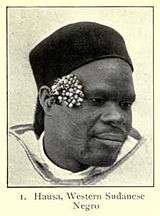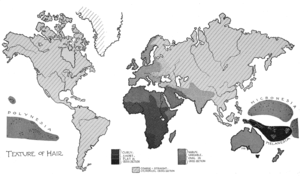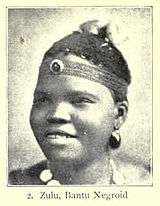Negroid
Negroid (also known as Congoid) is a grouping of human beings historically regarded as a biological taxon.[1] The term has been used by forensic and physical anthropologists to refer to individuals and populations that share certain morphological and skeletal traits that are frequent among most populations in Sub-Saharan Africa.[2][3] First introduced in early racial science and anthropometry, Negroid denoted one of the three purported major races of humankind (alongside Caucasoid and Mongoloid).[4] Many social scientists have argued that such analyses are rooted in sociopolitical and historical processes rather than in empirical observation.[5] However, Negroid as a biological classification remains in use in forensic anthropology.[6]
Etymology
Negroid has both Latin and Ancient Greek etymological roots. It literally translates as "black resemblance" from negro (black), and οειδές -oeidēs, equivalent to -o- + είδες -eidēs "having the form of", derivative of είδος eîdos "form".[7][8] The earliest recorded use of the term "Negroid" came in 1859.[9] In modern usage, it is associated with populations that on the whole possess the suite of typical Negroid physical characteristics.[10]
Subraces

| Caucasoid race: Negroid race: Uncertain: | Mongoloid race: |
In the 19th century, Samuel George Morton posited a "Negro Family", which he grouped with the Caffrian, Hottentot, Oceanic-Negro, Australian, and Alforian families.[11] In the first half of the 20th century, the traditional subraces of the Negroid race were regarded as being the True Negro, the Forest Negro, the Bantu Negro, the Nilote, the Negrillo (also known as the African Pygmy), the Khoisan (often historically referred to as Hottentot and Bushman), the Negrito (also known as the Asiatic Pygmy), and the Oceanic Negroids (consisting of the Papuan and Melanesian).[12] By the 1960s, some scholars regarded the Khoisan as a separate race known as the Capoid race, while others continued to regard them as a Negroid subrace.[13] The term "Congoid" was frequently used interchangeably with "Negroid", with the main difference being that Congoid excluded the Capoid taxon.[14]
Use in physical anthropology
In physical anthropology the term is one of the three general racial classifications of humans — Caucasoid, Mongoloid and Negroid. Under this classification scheme, humans are divisible into broad sub-groups based on phenotypic characteristics such as cranial and skeletal morphology.
Later iterations of the terminology, such as Carleton S. Coon's Origin of Races, placed this theory in an evolutionary context. Coon divided the species homo sapiens into five groups: Caucasoid, Capoid, Congoid, Australoid and Mongoloid, based on the timing of each taxon's evolution from homo erectus.[15][16] Positing the Capoid race as a separate racial entity, and labeling the two major divisions of what he called the Congoid race as being the "African Negroes" and the "Pygmies," he divided indigenous Africans into these two distinct groups based on their date of origin, and loosened classification from mere appearance — however, this led to disagreement between approaches to dating divergence, and consequent conflicting results.[16][17] Cavalli-Sforza also accepts this twofold division, pointing out that the Pygmies have a very different genetic signature than other Bantu language speakers. He thus proposes that they must have originally had their own now unknown language, but have since adopted the language of the Bantu peoples around them. Cavaill-Sforza does not accept as Coon did that each race evolved separately; he accepts the currently dominant paradigm, the Out of Africa theory (OOA),[18] i.e. that all humans outside of Africa are descended from small groups of people that migrated out of the continent beginning 125,000 to 60,000 years ago, and that populations within Africa are descended from either groups that remained within the continent or later back-migrated from Eurasia after the initial OOA exodus.[19][20]
Physical features
Craniofacial traits

In modern craniofacial anthropometry, Negroid describes features that typify skulls of black people. These include a broad and round nasal cavity; no dam or nasal sill; Quonset hut-shaped nasal bones; notable facial projection in the jaw and mouth area (prognathism); a rectangular-shaped palate; a square or rectangular eye orbit shape;[21] a large interorbital distance; a more undulating supraorbital ridge;[22] and large, megadontic teeth.[23]
According to George W. Gill and other modern forensic anthropologists, physical traits of Negroid crania are generally distinct from those of the Caucasoid and Negroid races. They assert that they can identify a Negroid skull with an accuracy of up to 95%.[24] However, Alan H. Goodman cautions that this precision estimate is often based on methodologies using subsets of samples. He also argues that scientists have a professional and ethical duty to avoid such biological analyses since they could potentially have sociopolitical effects.[25] Although widely used in forensic anthropology, some have also challenged the accuracy of craniofacial anthropometry vis-a-vis different human populations that have developed in close proximity to one another and those of mixed ethnic heritage.[26] Since the distinguishing racial traits are not set until puberty, they are also difficult to ascertain in preadolescent skulls.[22]
Variation in craniofacial form between humans has been found to be largely due to differing patterns of biological inheritance. Modern cross-analysis of osteological variables and genome-wide SNPs has identified specific genes, which control this craniofacial development. Of these genes, DCHS2, RUNX2, GLI3, PAX1 and PAX3 were found to determine nasal morphology, whereas EDAR impacts chin protrusion.[27]
Neoteny
Ashley Montagu lists "neotenous structural traits in which...Negroids [generally] differ from Caucasoids... flattish nose, flat root of the nose, narrower ears, narrower joints, frontal skull eminences, later closure of premaxillary sutures, less hairy, longer eyelashes, [and] cruciform pattern of second and third molars."[28] He also suggested that in the extinct Negroid group termed the "Boskopoids", pedomorphic traits proceeded further than in other Negroids.[28] Additionally, Montagu wrote that the Boskopoids had larger brains than modern humans (1,700 cubic centimeters cranial capacity compared to 1,400 cubic centimeters in modern-day humans), and the projection of their mouth was less than in other Negroids.[28] He believed that the Boskopoids were the ancestors of the Khoisan.[28]
Hair

Afro-textured hair is tightly coiled, kinky hair. It is a ubiquitous trait among Negroid populations. By consequence, the presence of looser, frizzly hair texture in other populations has often been considered an indication of possible admixture with Negroid peoples.[29]
Commenting on the lack of body hair (glabrousness) of Negroids and Mongoloids, Carleton S. Coon wrote that "[b]oth negroid and mongoloid skin conditions are inimical to excessive hair development except upon the scalp."[30]
Skin pigmentation
Skin pigmentation in Negroid populations varies from very dark brown to light brown.[10] As dark skin is also relatively common in human groups that have historically not been defined as "Negroid", including many populations in both Africa and Asia, it is only when present with other typical Negroid physical traits such as broad facial features, Negroid cranial and dental characteristics, prognathism, afro-textured hair and neoteny, that it has been used in Negroid classification.[29] Populations with frequently dark skin yet on the whole lacking the suite of Negroid physical traits were thus usually not regarded as "Negroid", but instead as either "dark Caucasoid" (e.g. Hamitic/Ethiopid and Arabid) or "Australoid" depending on their other salient physical attributes. By contrast, populations with relatively light skin yet generally possessing typical Negroid physical characteristics, such as the Khoisan, were still regarded as "Negroid."[29]
Criticism

Negroids | |
The term "Negroid" is still used in certain disciplines such as forensic and physical anthropology.[3] In a medical context, some scholars have recommended that the term Negroid be avoided in scientific writings because of its association with scientific racism.[31] This mirrors the decline in usage of the term Negro, which fell out of favor following the campaigns of the American civil rights movement — the term Negro became associated with periods of legalized discrimination, and was rejected by African Americans during the 1960s for "black".[32]
C.S. Coon's evolutionary approach was criticized on the basis that such "sorting criteria" do not (in general) produce meaningful results, and that evolutionary divergence was extremely improbable over the given time-frames.[33] As Monatagu (1963) said,
The notion that five subspecies or geographic races of Homo erectus [...] "evolved independently into Homo sapiens not once but five times" at different times and in different places, seems to me a very far-fetched one. Coon has striven valiantly, to make out a case for this theory, but it simply does not square with the biological facts. Species and subspecies simply do not develop that way. The transmutation of one species into another is a very gradual process [...][17]
See also
References
- ↑ Molnar, Stephen (2006). Human Variation: Races, Types, and Ethnic Groups. Pearson Prentice Hall. p. 4. ISBN 0131927655.
- ↑ Molnar, Stephen (2006). Human Variation: Races, Types, and Ethnic Groups. Pearson Prentice Hall. p. 23. ISBN 0131927655.
- 1 2 Fish, Jacqueline T. (2010). Crime Scene Investigation. Elsevier. p. 395. ISBN 1-4224-6331-1.
- ↑ Pickering, Robert (2009). The Use of Forensic Anthropology. CRC Press. p. 82. ISBN 1-4200-6877-6.
- ↑ Susanne Berthier-Foglar, Sheila Collingwood-Whittick, Sandrine Tolazzi (2012). Biomapping Indigenous Peoples: Towards an Understanding of the Issues. Rodopi. p. 186. ISBN 9401208662. Retrieved 11 July 2016.
The [American Anthropological Association] statement is representative of the prevailing view in the contemporary social sciences. Many social scientists have questioned the assumption that race is a scientific or objective reality, contending that it is forged from the discourses of politics, society, and history.
- ↑ Pickering, Robert (2009). The Use of Forensic Anthropology. CRC Press. p. 82. ISBN 1-4200-6877-6.
Race is both a cultural and a biological term. For more than a century, scientists and philosophers have tried to define race and describe races. Some scientists define only three races: caucasoid, mongoloid, and negroid, while other scientists have defined more than 10. In our climate of multi-cultural sensitivity, some scholars, not forensic anthropologists, suggest that race does not exist, or at least it should not be talked about.
- ↑ Company, Houghton Mifflin (2005). The American Heritage guide to contemporary usage and style. Houghton Mifflin Company. p. 512. ISBN 0-618-60499-5.
- ↑ "Oid | Define Oid at Dictionary.com". Dictionary.reference.com. Retrieved 2012-06-12.
- ↑ Harper, Douglas (November 2001). "Online Etymological Dictionary". Retrieved 2007-11-06.
- 1 2 Taylor, Karen T. (2010). Forensic Art and Illustration. CRC Press. p. 62. ISBN 1420036955.
- ↑ Morton, Samuel George (1839). Crania Americana: or a comparatif view of the skulls of various aboriginal nations of America. pp. 86–95.
- ↑ Ashley, Montagu (1951). An Introduction to Physical Anthropology – Second Edition (PDF). Charles C. Thomas Publisher. pp. 302–312.
- ↑ Jenkins (M.D.), Trefor (1988). The Peoples of Southern Africa: Studies in Diversity and Disease. Witwatersrand University Press for the Institute for the Study of Man in Africa. p. 6.
- ↑ Pearson, Roger (1985). Anthropological glossary. R.E. Krieger Pub. Co. p. 38.
- ↑ Jackson Jr., John (June 2001). ""In Ways Unacademical": The Reception of Carleton S. Coon's The Origin of Races". Journal of the History of Biology. 34 (2): 247–285. doi:10.1023/A:1010366015968.
- 1 2 Keita, S.O.Y.; Rick A. Kittles (September 1987). "The Persistence of Racial Thinking and the Myth of Racial Divergence". American Anthropologist. 99 (3): 534–544. doi:10.1525/aa.1997.99.3.534.
- 1 2 Dobzhansky, Theodosius; Ashley Montagu; C. S. Coon (1963). "Two Views of Coon's "Origin of Races" with Comments by Coon and Replies". Current Anthropology. 4 (4): 360–367. doi:10.1086/200401.
- ↑ "The great human expansion.". Proc Natl Acad Sci U S A. 109 (44): 17758–64. Oct 2012. doi:10.1073/pnas.1212380109. PMC 3497766
 . PMID 23077256.
. PMID 23077256. - ↑ Meredith M (2011). Born in Africa: The Quest for the Origins of Human Life. New York: PublicAffairs. ISBN 1-58648-663-2.
- ↑ Armitage SJ, Jasim SA, Marks AE, Parker AG, Usik VI, Uerpmann HP (January 2011). "The southern route "out of Africa": evidence for an early expansion of modern humans into Arabia". Science. 331 (6016): 453–6. Bibcode:2011Sci...331..453A. doi:10.1126/science.1199113. PMID 21273486.
- ↑ George W. Gill, Stanley Rhine (eds.) (1990). Skeletal Attribution of Race: Methods for Forensic Anthropology. Maxwell Museum of Anthropology. ISBN 0912535067. Retrieved 4 November 2016.
- 1 2 Wilkinson, Caroline (2004). Forensic Facial Reconstruction. Cambridge University Press. pp. 84–85. ISBN 0521820030. Retrieved 2 June 2015.
- ↑ Brace CL, Tracer DP, Yaroch LA, Robb J, Brandt K, Nelson AR, Clines and clusters versus "race:" a test in ancient Egypt and the case of a death on the Nile, (1993), Yrbk Phys Anthropol 36:1–31, p.18
- ↑ Gill, George W. 1998. "Craniofacial Criteria in the Skeletal Attribution of Race. " In Forensic Osteology: Advances in the Identification of Human Remains. (2nd edition) Reichs, Kathleen l(ed.), pp. 293–315.
- ↑ Diana Smay, George Armelagos (2000). "Galileo wept: A critical assessment of the use of race of forensic anthropolopy" (PDF). Transforming Anthropology. 9 (2): 22–24. Retrieved 12 November 2016.
- ↑ L’engle Williams, Frank; Robert L. Belcher; George J. Armelagos (April 2005). "Forensic Misclassification of Ancient Nubian Crania: Implications for Assumptions about Human Variation" (PDF). Current Anthropology. 46 (2): 340–346. doi:10.1086/428792. Retrieved 2007-11-06.
- ↑ Adhikari, K., Fuentes-Guajardo, M., Quinto-Sánchez, M., Mendoza-Revilla, J., Chacón-Duque, J. C., Acuña-Alonzo, V., Gómez-Valdés, J. (2016). "A genome-wide association scan implicates DCHS2, RUNX2, GLI3, PAX1 and EDAR in human facial variation". Nature communications. 7. Retrieved 12 November 2016.
- 1 2 3 4 Montagu, Ashley Growing Young Published by Greenwood Publishing Group, 1988 ISBN 0-89789-166-X
- 1 2 3 Keane, A.H. (1899). Man, Past and Present (PDF).
- ↑ Coon, C.S. (1939). The Races of Europe. USA: The Macmillan Company.
- ↑ Agyemang, Charles; Raj Bhopal; Marc Bruijnzeels (2005). "Negro, Black, Black African, African Caribbean, African American or what? Labelling African origin populations in the health arena in the 21st century". Journal of Epidemiology and Community Health. 59 (12): 1014–1018. doi:10.1136/jech.2005.035964. PMC 1732973
 . PMID 16286485. Retrieved 2007-11-06.
. PMID 16286485. Retrieved 2007-11-06. - ↑ "Ask Oxford – Definition of Negroid". Oxford Dictionary of English. 2007. Retrieved 2007-11-06.
- ↑ Carlson, David; Armelagos, George (September 1971). "Problems in Racial Geography". Annals of the Association of American Geographers. 61 (3): 630–633. doi:10.1111/j.1467-8306.1971.tb00812.x.








